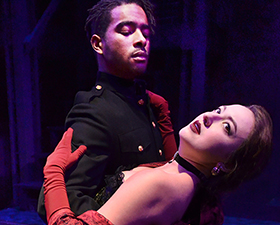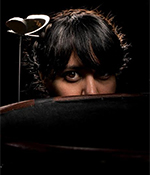From Theater Mania
A Tragic Love Story Takes Center Stage in Anna Karenina
February 27, 2018
By Adelaide Lee
It seems like people can’t get enough of Anna Karenina. In the 140 years since the publication of Leo Tolstoy’s novel, multiple adaptations have taken to the stage, including operas, ballets, and a disastrous 1992 musical. Anna Karenina has generally been mounted as a big-budget affair, as befits the grandeur of Russian high society. However, at Chicago’s Lifeline Theatre, Jessica Wright Buha’s new, streamlined adaptation captures the heart of the novel without the benefit of a large, opulent production. Furthered by compelling direction from Amanda Link and a young, vital cast, this Anna Karenina is as tragic as it is romantic.
Tolstoy’s novel is not only one of the great tragic love stories, but also a philosophical treatise on morality, social change, religion, and politics. Lifeline Theatre’s production focuses on the two main narratives of the novel: the love affair carried on between the married Anna Karenina (Ilse Zacharias) and army officer Vronsky (Eric Gerard) to her ruin; and the budding romance of Anna’s sister-in-law Kitty (Brandi Lee) and her childhood friend, reformist landowner Levin (Dan Granata). Their stories incorporate countless cousins, in-laws, and sundry aristocrats, moving between Moscow, St. Petersburg, various country estates, and all the trains and train stations in between.
In the title role, Zacharias shows the equal parts of fragility and passion that lead Anna to her tragic end. She looks at Vronsky, played by Gerard with the candor and shameless sexuality that the role requires, the same way a woman dying of thirst looks at a glass of water. When their lust turns to love, their feelings are visceral enough that it is a shame to see them wane in Act 2. Michael Reyes gives Karenin, Anna’s husband, something more than an icy, paternalistic disdain, allowing the audience to sympathize with the slighted man even while Anna despises him.
Highlights from the well-rounded supporting cast include Lee, who charms as the young idealist Kitty; and Michele Stine, whose vocal work and puppetry as the Karenin’s young son, Seryozha, is surprisingly moving. It’s a testament to the cast’s utter commitment, as well as Link’s direction and Stephanie Diaz’s puppet design, that many of Anna Karenina‘s most emotional scenes are shared with a little child puppet.
Though the religious elements of the novel are largely excised in this adaptation, Christian iconography is prevalent in a painted motif in Joanna Iwanicka’s scenic design. The cast looks sharp in Izumi Inaba’s costumes, that include furs, hats and fine coats that help set the play’s mood. Diane D. Fairchild’s dappled, painterly lighting adds to the play’s melancholy. Trains recur as a visual element, both in Iwanicka’s cleverly compartmentalized, modal set that serves as a broad variety of locales, as well as in the movement design by Kasey Foster.
From Picture this Post
Lifeline Theatre presents ANNA KARENINA: Beautifully Staged Tale of Misery
February 27, 2018
By Lauren Katz
HIGHLY RECOMMENDED
“Humans are destined for misery.”
Konstantin Levin attempts to explain to his maid why the woman he loves would refuse his marriage proposal. The line appropriately captures Levin’s negative and defeatist attitude that so accurately describes his character.
However, the line also acts as the perfect, one-line description for the story of Anna Karenina. Humans are always faced with choices, and while some may aim to search for the positive and hope, Leo Tolstoy clearly argues that any choice is simply one between the lesser of two evils.
Directed by Lifeline Theatre ensemble member Amanda Link and adapted from Leo Tolstoy’s novel by Lifeline ensemble member Jessica Wright Buha, the play carries many moving parts, but primarily follows the paths of Anna (Ilse Zacharias) and Levin (Dan Granata). Anna finds that she must make the impossible choice between following Vronsky (Eric Gerard), the man she loves, or remaining with her adoring son, but within a passionless marriage to Karenin (Michael Reyes). Levin finds himself in an impossible situation of his own – what will make him happy, and what is he willing to lose in order to discover that ultimate goal?
Set in late 19th century Russia, Budha’s adaptation beautifully captures the misery and devastation of the original novel. Tolstoy writes of individuals with troubling pasts and painful relationships, particularly within the title character, Anna. A woman in the late 1800s has little freedom, and Tolstoy shares the heartbreaking path of a woman who attempts to seize that happiness, and the unfortunate aftermath to follow. Buha’s Anna Karenina certainly is not hopeful, but the piece effectively lays out the story of a woman in an impossible situation, and invites the audience to consider how they would act in her place.
The Design
Lifeline Theatre’s intimate space offers the perfect mode of drawing the audience into the depths of the story, and creating an almost invasive sensation as they witness the inner workings of each relationship.
Set Designer Joanna Iwanicka’s stage is simple, but effective, with three levels on which the actors can play. The play follows multiple storylines, taking place in various locations from Russia to Italy, and the use of levels and moving staircases helps ease the audience into the understanding of the constant travel and complicated pathways.
Lighting Designer Diane D. Fairchild and Costume Designer Izumi Inaba collaborate to bring this elegant and dark world to life. Fairchild’s use of dark purples and blues beautifully emphasizes the dreary and mysterious mood of the piece. Inaba’s designs are gorgeous, and play a vital role in the storytelling – particularly in her gown choices for the ball.
The ball is a key scene in which everything begins to unravel. Kitty arrives at the party thinking that Vronsky will propose, but when he catches sight of Anna, everything changes. The moment sets the stage for everything that is to come, and Inaba’s choice to costume Kitty in white and Anna in a gown of red and black appropriately, but subtly brings attention to the danger of Anna’s presence.
Clever Staging
Link, in collaboration with Original Music and Sound Designer Eric Backus and Movement Designer Kasey Foster, creatively utilizes the ensemble to physicalize the moving parts of the story, from modes of transportation to heightening moments of key drama.
One example in particular takes place towards the beginning of the play when Anna is on a train to visit her brother and sister-in-law. Rather than building a train on stage, Backus creates the ambiance through his designs, and Link and Foster complete the sensation through actors’ bodies, and the use of repetitive and synced movement that signifies a moving train. The ending result is just as effective, but also adds an exciting layer to the piece.
The Ensemble
Link’s production utilizes the ensemble as a whole to tell the story, not only verbally, but also physically through movement, and the cast certainly rises to the challenge.
Anna’s son, Seryohza, is embodied in a wooden puppet, and Puppet Designer Stephanie Diaz creates a stunning prop for Michele Stine to use in portraying the character. Stine brings the youthful innocence of Seryohza to life, and masters the art of puppetry that adds a magical flare to the production.
Aneisa Hicks plays Dolly, Anna’s sister-in-law and numerous ensemble roles. Like the others, Dolly certainly has her tough decision to make when she finds her husband and father of her children has been cheating on her, and Hicks plays the devastation and difficulty of the journey with ease. On the other side of the spectrum, she showcases a charming and fun stage presence as the night-club singer later in the play, as well as a beautiful singing voice.
Granata and Lee as Levin and Kitty showcase a sweet relationship that is enjoyable to watch unfold. From the awkward beginning with an inability to share emotions to the difficulties of marriage that arise later in the story, Granata and Lee portray the relationship in a deeply authentic manner.
Zacharias carries no easy task in playing the role of Anna, but her performance is absolutely lovely. The character walks a truly devastating path, and Zacharias brings each stage in her story to life with an impressive honesty. Gerard and Zacharias share excellent stage chemistry, and the authenticity and hardship that the duo brings to the relationship only adds to the production. It is no surprise that Tolstoy refrains from granting Anna a perfect storybook ending, and Zacharias makes it easy for the audience to sympathize with this character’s impossible situation.
Creatively designed and beautifully acted, Buha’s adaptation offers an accessible and intriguing pathway into Leo Tolstoy’s classic.
From the Chicago Tribune
It’s Monday. It’s Rogers Park. And thanks to the strength of Chicago theater, it’s time for ‘Anna Karenina’
March 2, 2018
By Chris Jones
★★★
At the Lifeline Theatre, the soon-to-be-departing artistic director Dorothy A. Milne gave the usual little curtain speech about cellphones and emergency exits, winding up to her climax: “And now,” she said, as if introducing a new route for the parking shuttle bus, “here’s ‘Anna Karenina.’ ”
Why not, on a Monday night in Rogers Park in a small room with not much money?
The curtain speech moved me, for it encapsulated one of the greatest things about Chicago theater: ambition. It is easy to take it for granted, but there still aren’t many towns in the world where you can roll up and find a completely new adaptation of the jottings of Leo Tolstoy. As the show started, my head raced to all the obvious problems: How were they going to stage the unfortunate encounter with the train? The myriad settings, from Moscow to St. Petersburg to a spa in Germany? How were they going to deal with the dazzling experimentation of form and Anna’s explosion of stream-of-consciousness angst? How long are we all going to be here on a school night?
And what about the kids she has with the two dudes in Anna’s life? Big roles, those. Major issues all around: plenty of reasons to pass on this particular title.
But, you know, Lifeline pulls it off. At least that’s the case for the vast majority of the show — the last few minutes, when the heroine really hits the skids, don’t rush to enough of an inevitable crisis and the abundant early specificity and creativity turns into hurried compromise. Those last few minutes just don’t sufficiently embody the full complexity of loss. It basically feels like the director, Amanda Link, ran out of time. Which is forgivable, when you are doing “Anna Karenina” and you have done most of it so well.
The show’s great strength is the world-premiere adaptation, by Jessica Wright Buha, remarkable for how well it dramatizes the whole show. By dramatizes, I mean it does the job without narration: Anna does not share her inner thoughts. No ensemble head pops up to say, “Anna went to Rome” and thus sweep us to a different place.
Rather, Buha has turned every scene in the novel into dialogue. It’s an impressive feat — and it makes this production an ideal introduction to Tolstoy, indeed to romantic Russian realism, for a young person, long a strength at Lifeline. In so doing, Link takes a few more risks than has been typical at this theater — wading into some cool theatrical devices, including bodies that heave and sigh on cue. Anna’s beloved but abandoned son, Seryozha, is imagined as an emotionally resonant puppet, manipulated quite beautifully by Michele Stine. I got a real lump in my throat when the puppet asked the reasons for his abandonment, a question that Anna Karenina cannot answer, and from which she never can recover.
You have to make choices to bring in “AK” at 2½ hours, and Buha goes mostly with the sharp edges of the love-triangle between Anna (Ilse Zacharias), hubby Karenin (Michael Reyes) and, of course, her beloved but illicit Count Vronsky (Eric Gerard). The show works up plenty of heat between Anna and Vronsky — vroom, vroom — and contrasts that very nicely with Reyes’ irritating but still empathetic Karenin, making it all a microcosm of why people have affairs, which is a cool way to go.
Tolstoy, of course, was a master of precise characterization, which Buha really does exploit very well. And Link, to her credit and with great help from the honest Zacharias, avoids the trap of hyperventilation or bathos, into which movies based on Tolstoy often sink.
You watch this show very much involved in Anna’s situation — and the adaptation puts its focus on the situational, the things that get in the way of happiness, the irreconcilability of choice and obligation. And it notes with particular force that almost all these obligations were things over which a woman in this particular time and place had very little control.
From Buzz Center Stage
In Anna Karenina, Marriages Fail Or Succeed, Each In Their Own Way
March 2, 2018
By Bill Esler
Every unhappy family is unhappy in its own way, said Tolstoy. And Lifeline Theatre artfully explores that famous maxim in Anna Karenina, its colorful and artful adaptation of Tolstoy’s novel.
The story of Anna Karenina follows a 19th century woman’s fall from grace. Dutiful but unfulfilled in her marriage to Karenin, an unimaginative Russian government bureaucrat, Anna compensates by doting on her six-year-old son – until an affair up-ends everything, leading to tragedy.
I have to admit that the idea of Anna Karenina being adapted for Lifeline Theater’s stage was a little off-putting. After all, Leo Tolstoy’s poignant examination of a woman’s inner struggle is regarded as a pinnacle in writing, called “flawless” by both Dosteyevsky and Nabokov, and “the best ever written” by Faulkner. It’s so good it has inspired nine operas, four ballets, and 18 different movies.
What does Lifeline Theatre bring to the party after all that? Something good, it turns out – with a creative approach that captures key aspects of the novel – while delivering more than a Cliff’s Notes summary. Anna Karenina – both the play and the novel – is largely melodrama, ending in tragedy. Tolstoy’s skillfully drawn characters provide the emotional touch points that remain fresh today, and can work on stage.
Challenging, though, is the Tolstoy’s sweeping scope and settings – estates, boulevards, palaces and mansions in St. Petersburg and Moscow, and the trains and farms between them – which may explain why it has been adapted just twice before for stage. It’s hard to bring all that to the boards.
But cramming a lot of life into a little stage is where Lifeline Theatre excels. Ensemble members Jessica Wright Buha (playwright and adaptor) and Amanda Link (director) have done a colorful, even exciting job. Crowding the two-story stage in a series of vignettes of key scenes from the novel are eleven performers, along with puppets designed by Stephanie Diaz (these play the role of infants and children).
Players shift from principal characters to ensemble roles, performing sometimes in stylized movements and sounds that create what is in some respects is more performance piece than dramatization of Anna Karenina. Excellent lighting (Diane D. Fairchild), and original music and sound design (Eric Backus), build key scenes from the novel. Perhaps as a result, individual performances are subordinated to the overall creative presentation. Actors are on stage in short shots, not aimed at building character, so much as advancing the storyline.
Buha summarizes Tolstoy effectively by focusing on four parallel relationships: Anna and her husband Karenin; Stiva and his wife Dolly; Vronsky and his two paramours; Kitty and her husband Levin – allowing us to compare and contrast the best and worst of these pairings.
The action opens with Countess Anna (Ilse Zacharias ably carries this demanding role) heading to visit her brother, Prince Stiva Oblonsky (Dan Cobbler brings great energy), who has had an extramarital affair. He and his wife Dolly agree to Anna’s counsel to stay and pick up the pieces. But Dolly (Aneisa Hicks in one of the stronger performances) voices her predicament: “How can I stay?,” she asks Anna. “But if I leave, where will I go?” It’s an apt summary of a woman’s plight at the time, and foreshadow’s Anna’s own situation.
In the novel intellectually curious and quite lovely, Anna catches the eye of Count Vronsky, a widely admired young officer for whom women swoon. Truly smitten, Vronsky sets his sites on seducing Anna, abandoning 18 year old Kitty, the debutant to whom he was nearly engaged.
Eventually Anna falls for Vronsky, becomes pregnant, and her options narrow – dictated by convention. Her husband Karenin is willing to turn a blind eye to the affair to maintain the marriage; or Anna can seek a divorce, but will likely lose custody of her son.
Eric Gerard as Vronsky puts forth a believable animal magnetism, but seemed more of a caricature at first. In later scenes he is compelling in his desperation to move Anna to divorce, and commit fully to life with him. Kudos also to Gay Glenn, who brings the gravitas to play Vronsky’s mother, Countess Vronskaya; Lindsey Dorcus as Anna’s enabler (and Vronsky’s cousin) Betsy; and Jason Pereira as Kapitonich, a composite character.
Anna’s husband, Karenin (Michael Reyes is suitably doltish), is willing even to endure an open marriage and adopt her child with Vronsky, if Anna can maintain some semblance of discretion. Another character, family friend Levin (Dan Granata acts well but did not project from the stage), struggles to get married, and suffers endless angst after Kitty, spurned by Vronsky, agrees to marry, reversing an earlier refusal. Brandi Lee’s Kitty moves adeptly from disappointed ingenue, to practical mother and wife, coaching her diffident husband to overcome his self doubt.
The production runs two and a half hours with an intermission, and is surprisingly fast paced and engaging. Anna Karenina runs through April 8 at Lifeline Theatre.
From Windy City Times
March 5, 2018
By Mary Shen Barnidge
Compared to his earlier War and Peace, Leo Tolstoy’s thousand-page Anna Karenina may have been a light read for the Russian intelligentsia during the turbulent years before the revolution. However, while its tale of passion among the privileged continues to resonate in 2018, literary consumers today are more likely to encounter it within the abbreviated dimensions of its many adaptations—cinematic, operatic and balletic—making Jessica Wright Buha’s tidy two-and-a-half-hour synopsis a welcome addition to the list.
Dramatically, the narrative recounts the connubial adventures of three aristocratic households, two of them already troubled at the very outset. Indeed, the errand bringing Anna, our heroine, to the big city of Moscow is an intercession on behalf of her philandering brother. No sooner has his wife been persuaded to adhere to her marriage vows, however, than Anna meets the dashing officer Alexei, with whom she embarks upon an adulterous affair complicated by her reluctance to divorce her boring husband—thus surrendering custody of her young son—and the inability of the illicit paramours to conceal their mutually obsessive attachment.
Since the tenets of Romanticism mandate lovers behaving in selfish and foolish ways, playgoers of less empathetic bent may opt to analyze the lessons in responsibility offered by Tolstoy, who presents us with problems—spousal age gaps, extramarital infatuations, self-defeating goals—and then proposes solutions, the consequences of which we can assess for ourselves. For example, in contrast with her emotion-racked kin, the adolescent Kitty Oblonsky willingly chooses to marry a childhood friend a few years older than herself—the shy and bookish Levin—but soon demonstrates a maturity conferring contentment upon their union.
Lifeline Theatre’s technical staff proves likewise capable of delivering the miracles necessary to create grand-scale cosmology in a physically restricted space. Amanda Link’s visual direction encapsulates a child’s anguish in a wooden-faced marionette, the pains of parturition in a red-stained bedsheet and the progress of Anna and Alexei’s fatal liaison in a pas de deux endowing a Mazurka’s marching-drill choreography with the smoldering sensuality of a tango. Joanna Iwanicka embellishes her constructivist scenic design with motifs drawn from the radical Symbolist Art movement of the period, while Izumi Inaba’s wardrobe spans pre- and post-World War I fashions, both hinting at the era of social emancipation to come.
From Chicago Onstage
Lifeline’s “Anna Karenina” Shines, Though Act Two Proves Daunting
March 2, 2018
By Karen Topham
“All happy families are alike; each unhappy family is unhappy in its own way.”
So begins Anna Karenina, a Promethean study of the heart’s capacity for profound love, reckless passion, hopeless frailty, and torturous self-doubt. As a work of realistic fiction, Anna Karenina is a masterpiece. And, every bit as seductive as the novel’s main character, Anna’s siren song has called out to artists, luring them to bring her tragic story to the stage. Yet, this call–like so many of the choices Anna makes throughout her story–is fraught with the potential for disaster.
More on this later.
Lifeline’s Anna Karenina has no shortage of redeeming qualities. The ensemble cast and crew are teeming with talent, and, from the arrival of the first train that begins the play, it’s clear that they’ve wholeheartedly leapt into the task of bringing Anna to the stage. From the stage design to the litany of strong performances by the ensemble cast, to the flawless direction of Amanda Link and her captivating use of space, sound, light, and set, the play is, by turns, creative, arresting, heartbreaking, and transporting.
The adaptation by ensemble member Jessica Wright Buha’s reflects what must have been a daunting task: to whittle a 900+ page odyssey of life, love, and marriage in late 19th century Russia down to a 2 ½ hour theater experience. Yet, throughout the first act, from her first moment onstage when Anna says goodbye to her young son, Seryohza–brought to life as a puppet, artfully designed by Stephanie Diaz and voiced by Michele Stein–to her fateful decision to leave her family, Buha’s adaptation puts Anna’s deeply passionate, intelligent, profoundly conflicted soul on full display. Ilse Zacharias’s take on the role boils over with energy and emotion as she grows more compelling, complex, and beautifully conflicted with each scene.
Anna’s trip to Moscow is a mission to save the marriage of her brother Stiva (Dan Cobbler), who has been unfaithful to his wife Dolly (Aneisa Hicks). Cobbler is excellent as the unrepentant, unapologetic Stiva, while Hicks gives a solid performance as the scorned wife who chooses to make it work when faced with nothing but uncertainty for herself and her children. But her life changes course when she meets Count Vronsky (Eric Gerard), a rich, charming, virile, man in uniform, with no qualms about ditching his young love interest, Kitty (Brandi Lee), and throwing himself, body and soul, at a married woman. Gerard is true to the part, though at times, in both the novel and play, it’s difficult to tell what deeper motivation drives his character–or maybe it’s really not that complicated.
Nonetheless, Vronsky follows Anna back to her home in Petersburg–where she has returned to Seryosha and her husband, the utterly moral but hopelessly distant Karenin, expertly played by Michael Reyes. Vronsky and Anna begin a passionate affair that changes the course of their lives. Anna soon finds that her love for Vronsky is impossible to deny or hide. She confesses her affair and reveals she is pregnant with Vronsky’s child. Following her daughter’s birth, Anna is brought to the brink of death by a fever, and she calls both men to her bedside. In an unexpected hallucinatory soliloquy, she seemingly chooses her husband Karenin, recognizing his inherent goodness. But after her recovery, Vronsky’s attempted suicide prompts Anna to leave her husband and son and run away with her lover.
Running parallel to Anna’s tempestuous affair with Vronsky is the story of the engagement and marriage of Levin and Kitty, played by Dan Granata and Brandi Lee. Cast in the role of the stable couple, Granata and Lee shine together as he exhibits Levin’s growing self-doubt and questioning while she demonstrates Kitty’s countervailing certainty and strength.
Levin travels to Moscow to ask Kitty to marry him, but she, like many, is smitten with Vronsky, so she initially rejects Levin’s proposal.
But, later, the two reconcile after Levin learns that Kitty has been utterly forgotten by Vronsky and has taken ill with heartbreak. He arranges to meet her again and she asks for Levin’s forgiveness. He wastes no time in telling her that he can both “forgive and forget”. What follows should be a relatively mundane marriage, at least compared to the firestorm Anna and Vronsky have plunged into, but, as it turns out, the relationship still provides Levin with more than enough potential for intense emotional searching, self-loathing, and existential crisis.
And all of this before intermission.
Herein lies the potential for disaster.
Tolstoy once described Anna Karenina as his first “true” novel. The stories of Anna and Levin challenge us to abandon the urge to make simple judgments and grow in our humanity as we come to grips with the way our inherent virtues and best intentions co-mingle with deep desires that threaten to unravel our lives.
Tolstoy’s characters are absolutely compelling. We dive deep into their minds. We watch as they make their way through relatively minor moments and small, insignificant decisions. We bear witness to their redeeming qualities and eccentricities. So when Anna does something that might seem utterly crazy–like leave the son she adores and husband she admits is good man–we, somehow, get it. And when Levin–who we’ve watched build a life pretty close to the one he always imagined–is making his way through yet another self-imposed existential crisis… we get it.
Why do we get it? Because we have mowed the lawn with him for six pages earlier in the book. Honestly, Tolstoy devotes an entire chapter to describing Levin scything the grass with the peasants while he thinks about his life. So we know he likes to think about stuff because we’ve seen him do it before. And it all pays off. We are richly rewarded. We have been on their journey, so we understand why they do what they do, even when we don’t agree with them. In the end, Levin does what Anna fails to do: he comes to grips with his life. He decides to live, and he tries not to worry so much about the parts of his life he can’t fix.
Unfortunately, the problem for Lifeline’s Anna Karenina is that there’s not enough time. In an effort to stay faithful to the book in the second act, the play cherry picks the most dramatic decisions, but doesn’t give time for the context that allows these choices to make sense, so the play moves at a breakneck pace through a series of nakedly raw emotional moments that, at times, don’t add up. Midway through the act, the energy and emotion of the first act have waned. Vronsky seems boorish and angry, Anna appears hopelessly lost, Levin is incessantly whining for no discernible reason, and we feel sorry for poor Kitty who has to put up with him. The performances are still strong, but without context, the play descends into a study in anxiety, self-loathing, and poor decision making, as the characters hurtle ever deeper into largely avoidable misery.
Still, even with the rocky second act, this production shows genuine courage. What’s lost in terms of Tolstoy’s “truth”, is made up for by bravery, fine performances, style and overall production value. While it’s tough to imagine what it must be like to try to adapt a book as complex and consequential as Anna Karenina, it’s equally tough not to admire the writer, director, cast and crew for throwing caution to the wind and going for it. And considering there are more than a few genuinely wonderful moments, not to mention great performances, to be found in the play, it’s definitely worth it.

































